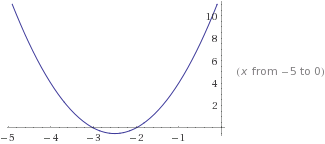This section contains information on long division of polynomials, synthetic
division, the remainder theorem and
the rational zero test.
Long Division of Polynomials
One way to divide polynomials by other polynomials is to use
long division.
After dividing, we can tell that the remainder is zero
because there are no numbers that are left over. Since we know (x+3)(2x+4)= we can find
the x intercepts of the graph:
we can find
the x intercepts of the graph:
 we can find
the x intercepts of the graph:
we can find
the x intercepts of the graph:
(x+3) (2x+4)
x+3=0 2x+4=0
x=-3 x=-4/2
x=-2
The x intercepts are located on the graph at x=-3 and x=-2.
When dividing polynomials, sometimes there will be a
remainder that is left over.
In this equation, the remainder is -23. The answer to this
problem can be written as:
Synthetic Division
Synthetic division is another method you can use when
finding the zeroes of polynomials.
Setting it up: 1. The
divisor is x+3 which means that x=-3. The -3 is placed to the left.
2. The coefficients of the dividend are 2, 10
and 12. These numbers are placed in
order to the right of the -3.
Step 1: Bring down the 2
Step 2: Multiply
the 2 by -3= -6
Step 3: Add 10
+ (-6) = 4
Step 4: Multiply
the 4 by -3= -12
Step 5: Add 12
+ (-12) = 0
When using synthetic division, multiply the terms going diagonally
and then add the terms vertically. x+3 is a factor of the equation because it
has no remainder. If there was a remainder, then x+3
would not be a factor.
Since the remainder is 12, x+5 is not a factor.
The Remainder Theorem
The remainder theorem:
f(k)=r
If a polynomial f(x) is divided by x-k
Using the remainder theorem we know F(-6) =-65
This tells us that (-6, -65) is a point on the graph of f which can be seen below.
If this polynomial
Has integer coefficients, every rational zero of f can be found using this equation:
*These are only the possible rational zeroes. They can be
tested individually using synthetic division to determine if they are actual rational zeroes.
Example: Test x=-1 to see if it is a rational zero
Example: Test x=-1 to see if it is a rational zero





.gif)

.gif)
.gif)
.gif)
.gif)

.gif)
.gif)
.gif)
.gif)
.gif)
.gif)
No comments:
Post a Comment